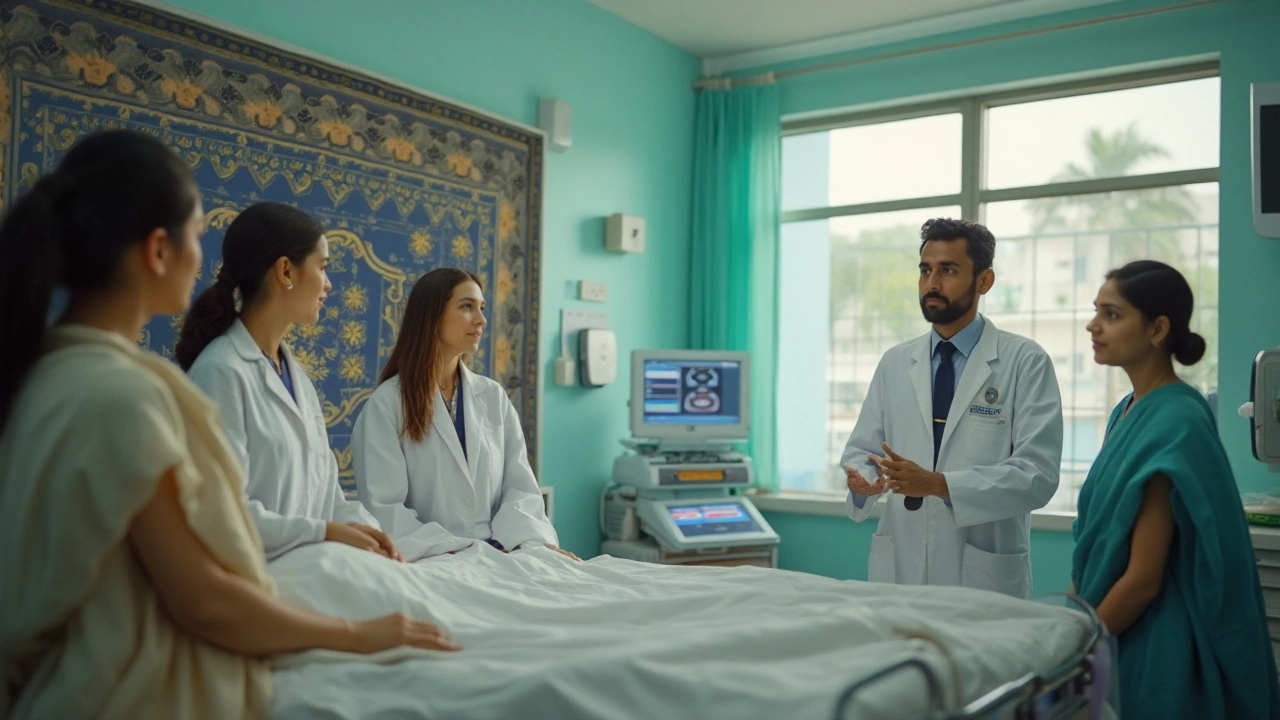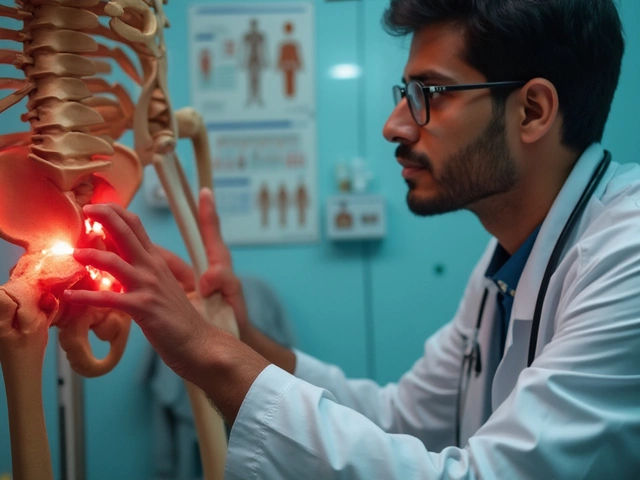Cancer is a disease that can strike any part of the body, but not all cancers are created equal. Some are known for their particularly aggressive behavior, spreading rapidly and becoming difficult to treat. These forms of cancer can be frightening, but understanding them is the first step toward defeating them.
In this article, we'll explore what makes these forms of cancer so aggressive and examine the specific challenges they present. We'll also delve into the stories of some of the most notorious types out there, shedding light on the battle faced by patients and researchers alike. Knowledge is a powerful tool, and staying informed can make all the difference in the fight against cancer.
- Defining Aggressive Cancer
- Spotlight on Pancreatic Cancer
- Understanding Small-Cell Lung Cancer
- Unraveling Glioblastoma
- Advancements and Hope in Treatment
Defining Aggressive Cancer
When we talk about aggressive cancer, we're referring to types of the disease that grow and spread more quickly than others. This rapid progression often leaves doctors and patients scrambling to catch up. The speed at which these cancers advance means they can invade nearby tissues and metastasize to distant parts of the body with alarming haste. Such behavior not only complicates treatment but also diminishes the likelihood of successful long-term management and survival. Understanding what makes a cancer aggressive goes beyond mere speed, involving a deeper dive into the biology of cancer cells and how they defy the usual processes that keep cells in check.
The aggressive nature of certain cancers is often due to unique genetic mutations that drive tumor cells to replicate uncontrollably. Additionally, these mutations might also equip cancer cells with the ability to evade the immune system or resist traditional therapies. In some cases, aggressive tumors are composed of a higher proportion of stem-like cancer cells, which contribute to a greater capacity for renewal and spread. A significant challenge in treating these cancers is their heterogeneity; no two tumors are exactly alike, even within the same type of cancer. This genetic and molecular diversity makes it challenging for a one-size-fits-all treatment strategy to be effective.
The Human Impact
The term "aggressive" doesn't just refer to biological factors—it also signals the urgent need for timely intervention. The aggressive label carries substantial emotional weight, often leading to a significant psychological impact on patients and their families. Such diagnosis demands swift action in both medical and personal terms. We often hear narrative accounts of patients channeling their frustration and fear into urgent determination, driven by the notion that each moment counts.
"An aggressive cancer diagnosis doesn’t just change your health outlook; it alters your entire life's timeline," says Dr. Jane Frazier, a noted oncologist and author on patient care.This shift underscores why rapid detection and innovative approaches in research are critical to gaining ground against these cancers.
Scientifically, the often unpredictable nature of aggressive cancers makes studying them both fascinating and frustrating. Each case offers a unique set of challenges and insights into cancer's ability to adapt and survive. Researchers are constantly analyzing data to understand what triggers rapid growth and spread in these tumors compared to others. Some studies focus on finding biomarkers that could predict aggressive behavior early on, ideally before metastasis occurs, allowing for more tailored treatment approaches. Research continues to expand the weapons in the oncologist's arsenal, providing hope in the form of precision medicine, immunotherapies, and other cutting-edge treatments—each designed to target these relentless forms of the disease more effectively.
Spotlight on Pancreatic Cancer
Pancreatic cancer is often described as one of the most aggressive and deadly cancer types, distinguishing itself with its formidable resistance to treatment. The pancreas, a small gland located behind the stomach, plays a crucial role in digestion and hormone production. When cancer strikes this vital organ, it typically grows swiftly and secretes its malignant cells into nearby organs. One reason for its aggressive nature is the often late diagnosis. Symptoms tend to appear only after the disease has advanced, making early detection a fiercely challenging task. Common symptoms include jaundice, weight loss, and digestive problems, yet these can easily be mistaken for other illnesses, resulting in delayed treatments.
The statistics around pancreatic cancer are stark and sobering. According to the American Cancer Society, the five-year survival rate for pancreatic cancer is a mere 10%, one of the lowest among major cancers. This percentage underscores the urgency needed in addressing this disease. The larger part of this challenge lies in its silent progression. Routine screening tests for pancreatic cancer are not as established as those for other cancers like breast or prostate, which complicates early-stage detection.
Despite these daunting odds, research has been pouring into developing better diagnostic and treatment methods. The focus has been intensively set on improving imaging techniques and identifying specific genetic markers that could alert to an early onset. Scientists are continuously trying to unravel the hidden biology of pancreatic tumors to identify vulnerabilities. The words of Dr. Christine Iacobuzio-Donahue from Johns Hopkins encapsulate the plight and hope, "Pancreatic cancer is biologically cunning, but so are we. Each day brings us closer to understanding its complexity even more."
Efforts to combat pancreatic cancer aggressively focus not just on treatments but also on prevention and risk awareness. Lifestyle factors such as smoking and obesity have been linked to an increased risk, encouraging a broader societal shift toward healthier living as a preventative measure. Researchers are investigating early risk factors and environmental influences that could help develop preventive strategies to safeguard at-risk populations. This battle against pancreatic cancer is not solely about eliminating the disease but also about empowering people with knowledge and resources to manage their health proactively.
On the treatment frontier, a combination of surgery, radiation, and chemotherapy remains the standard approach, with emerging treatments like immunotherapy gradually finding their place. The challenge, however, is tailoring these treatments to individual patients, as responses can vary significantly. Although the journey is fraught with hurdles, each scientific discovery brings new hope. The pursuit of understanding and overcoming pancreatic cancer is relentless, driven by the resilience of patients and the dedication of researchers worldwide.

Understanding Small-Cell Lung Cancer
Small-Cell Lung Cancer (SCLC) is a highly aggressive form of lung cancer characterized by rapid growth and early metastasis. This form of cancer accounts for about 15% of all lung cancer cases. What's particularly insidious about SCLC is its ability to spread quickly to other parts of the body, often before it is even detected. The two primary types are 'limited stage,' where the cancer is confined to a single area, and 'extensive stage,' which means the cancer has spread beyond one lung and may have reached other organs.
SCLC is strongly linked to smoking, with around 95% of SCLC patients having a history of tobacco use. The carcinogens in cigarette smoke trigger mutations in the lung cells, which then grow uncontrollably. While quitting smoking significantly reduces your risk, the damage may already be done for long-time smokers, making this disease particularly hard-hitting. Another factor complicating treatment is that SCLC responds initially well to chemotherapy and radiation but has a high recurrence rate, often within just months of treatment.
"Small-cell lung cancer is the most aggressive form of lung cancer. Early treatment can make a significant difference, but recurrence rates remain high," says Dr. Susan Swain, a leading oncologist.
For those diagnosed with SCLC, early detection and prompt treatment are crucial. Unfortunately, because SCLC often doesn't cause symptoms until it has spread, catching it early proves challenging. Symptoms can include persistent cough, chest pain, shortness of breath, and unexplained weight loss. For this reason, high-risk individuals, especially smokers and former smokers, are advised to undergo regular screenings.
- Smoking cessation for prevention.
- Screening for early detection, particularly for high-risk individuals.
- Potential treatment options include chemotherapy, radiation, and immunotherapy.
Treatment advancements are ongoing, with researchers exploring targeted therapies that could better arrest the spread of SCLC. Though not as common as some other lung cancers, SCLC presents unique challenges due to its unpredictable nature and the speed at which it metastasizes. Efforts to improve early detection and create more effective treatments are essential in improving prognosis. Experts emphasize the importance of personalized treatment plans tailored to the specific needs and genetic makeup of each patient to enhance the effectiveness of therapy and resilience to recurrence.
Unraveling Glioblastoma
Glioblastoma is a name that sends shivers down the spine of anyone who hears it. It's considered one of the most aggressive cancer types, cornering patients into a tiny space where options feel limited. The tumor primarily targets the brain and the spinal cord, presenting itself as a rather unwelcome guest in the central nervous system. Its speed and aggression are almost unmatched in the world of oncology. Not one to sit still, glioblastoma grows quickly, outpacing many other cancers in terms of progression. Scientists and doctors alike are constantly on their toes, trying to manage this relentless adversary with the tools at their disposal.
Understanding glioblastoma begins with recognizing its nature. It's a grade IV astrocytoma, according to the World Health Organization's classification, and this classification itself is a testament to its virulence. The cellular architecture is complex, and its ability to infiltrate surrounding tissue makes it all the more dangerous. This invasive growth means that surgery, often the first line of defense, faces considerable hurdles because completely resecting the tumor without damaging vital parts of the brain is extremely difficult if not impossible. The tumor cells disguise themselves well, often intermingling with healthy tissue, complicating treatment efforts.
'Glioblastoma is an exceptionally complex cancer to treat, and its aggressiveness presents unique challenges,' said Dr. Lisa DeAngelis, Chair of the Department of Neurology at Memorial Sloan Kettering Cancer Center.
One striking feature of glioblastoma is its ability to recruit a network of blood vessels. This vascular network feeds the tumor, supporting its rapid growth and helping it thrive in an otherwise hostile environment. Tumors develop their own blood supply, a process known as angiogenesis, to maintain a constant influx of nutrients and oxygen. The blood-brain barrier, usually a protector of the brain from harmful substances, becomes compromised in the presence of such aggressive tumors, sometimes even aiding in spreading the cancer cells further.
Clinical Approaches and Challenges
Treatments for glioblastoma typically involve a combination of surgery, radiation therapy, and chemotherapy. Temozolomide is one of the most common drugs used, alongside radiotherapy. Studies consistently show that this cocktail tends to extend survival times, but not without significant side effects and with varying degrees of success. Herein lies a challenge; while there may be a temporary relief or slowed progression, the aggressive nature of glioblastoma means recurrence rates remain high. This cancer tends to come back, often more resilient and difficult to treat. Research continues to look for molecular pathways and biological markers that could unlock new targeted therapies and improve outcomes.
| Treatment | Outcome |
|---|---|
| Surgery | Reduces tumor bulk but challenging to remove completely |
| Radiation Therapy | Targets remaining cancer cells but can impact healthy brain tissue |
| Chemotherapy (Temozolomide) | Prolongs survival but comes with potential side effects |
Emerging treatments are exploring innovative approaches such as immunotherapy and personalized medicine, aiming to tailor treatments to the genetic makeup of the individual's tumor. The hope through these advanced techniques is to find a weak link, a chink in glioblastoma's seemingly impenetrable armor. With every study and every clinical trial, researchers inch closer to understanding this complex foe, offering a glimmer of hope amidst the challenges of facing one of the most deadly cancers.

Advancements and Hope in Treatment
Over the past few decades, the landscape of cancer treatment has witnessed remarkable transformations, with many races against time yielding promising results. The fight against aggressive cancer types has seen particularly groundbreaking innovations. Among these innovations, the integration of personalized medicine has taken center stage. This approach tailors treatment to the individual's genetic makeup, effectively catering to the complexities unique to each patient's cancer profile. Leveraging the power of genomics and molecular biology, doctors can not only predict how certain cancers might behave but also devise strategies that offer the best chance of success.
Immunotherapy has emerged as a beacon of hope in the field of cancer treatment. By essentially teaching the immune system to recognize and combat cancer cells, treatments such as PD-1 inhibitors and CAR-T cell therapy have shown promise, especially in cases where traditional therapies fall short. The idea is to bolster the body's natural defenses to specifically target aggressive cancer cells without harming healthy tissue. In a recent report from the National Cancer Institute, it was noted, "The potential of immunotherapy to transform cancer care is unlimited." This milestone has not only provided hope but has also created a domino effect, inspiring similar therapies tailored for aggressive cancers like pancreatic cancer and glioblastoma.
The application of artificial intelligence (AI) and big data analytics in oncological research marks another significant advancement. With these technologies, patterns that were once hidden in vast amounts of data are now being deciphered. This data-driven approach provides insights that might otherwise take years to uncover, speeding up the timeline for breakthroughs in treatment options. Researchers are keen on using AI to predict outcomes, tailor patient-specific treatment plans, and identify potential drug candidates. This amalgamation of technology and science holds the promise of improving treatment efficiency and effectiveness exponentially.
Multiple clinical trials are also spearheading the future of cancer therapy. Novel compounds and treatment modalities are being tested to see if they can beat the stubborn nature of these strong and aggressive cancers. Participation in clinical trials has given many patients early access to cutting-edge therapies, sometimes providing a viable option where standard treatments would fail. Collaborative efforts among leading cancer research centers across the globe have accelerated progress. These trials often garner insights that contribute significantly to understanding and treating cancers like small-cell lung cancer and others alike.
Lastly, the community surrounding cancer care and treatment should not be overlooked. Patient advocacy groups, support networks, and nonprofit organizations play a crucial role in raising awareness and raising funds for research that fuels innovation. Education and psychological support for patients and their caregivers is also fundamental in ensuring a holistic approach to cancer treatment, reinforcing the belief that no one fights alone. Such efforts underscore the importance of community, reinforcing the idea that though the battle against aggressive cancer is daunting, it is not without allies and hope. The journey might be grueling, but with continuous support and relentless research, brighter days are within reach.





